4 Resistance Band Tricep Workouts: A Complete Guide
Author:
Unlock your full potential by engaging with our experts and community! Have questions about your fitness journey or looking for expert advice on weightlifting techniques? Don’t hesitate — leave a comment below and Ihor Shymechko will provide a personalized answer and insights to help you reach your goals.
Torokhtiy is reader-supported. Some links are affiliate links, and we may earn a commission at no extra cost to you. See our disclosure page for details.
Resistance bands have been used in place of free weights for several workouts. Tricep workouts are no different. Training your triceps can be done just as effectively with resistance bands. So what are resistance band tricep workouts? Why should you do them? We’ll discuss all that and more in this article.
First, the short answer.
Resistance band tricep workouts are a great way to develop your tricep muscle. They increase joint stability, muscle strength, and explosive power. Resistance bands are also easy on your muscles if you’re nursing an injury and easy to carry around if you’re busy.
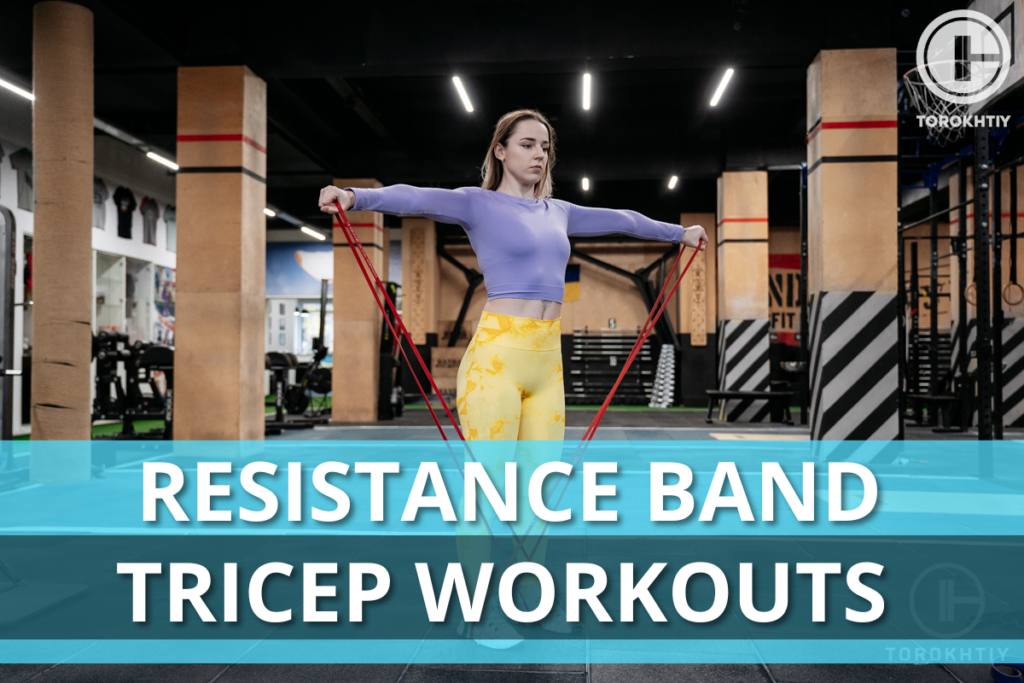
Band Tricep Workout: a Deep Dive
Triceps are on the other side of your biceps. In a world where bicep development takes all the headlines, tricep workouts have been often ignored. Unknown to many, tricep development is just as important as bicep development because it makes up almost half of your upper arm. To build strong arms, you must train both your biceps and your triceps. Failure to train your triceps will result in fat gathering back there and reducing your overall arm strength and stability.
Free weights are the popular equipment of choice for tricep workouts. But if you’re a busy person wondering how to stay consistent with your tricep workouts, resistance bands are exactly what you need. They’re easy to carry around and very effective when used. They also come in different resistance levels up to an equivalent of 200 lb. Resistance bands are also easier on your muscles. This makes them perfect for people in some discomfort or physical rehabilitation.
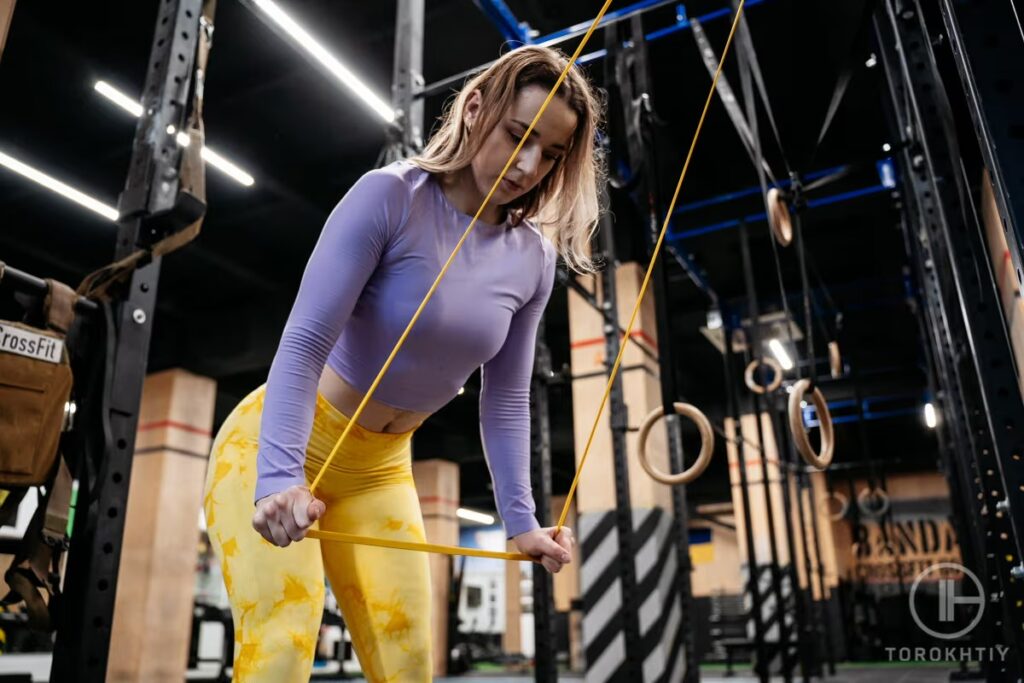
To understand exactly what tricep resistance band workouts do and their benefits, we must first understand the anatomy of the tricep…
Tricep Anatomy
Like I’ve already said, the tricep is on the other side of the bicep. If you extend your arm out straight as far as you can, you’ll find a bulge on the back of your upper arm. That’s your tricep in all its glory. The tricep’s main job is to move the lower arm and the joints in your arms such as your elbow and wrist. It’s responsible for all pushing movements, whether it’s a broken down car or a barbell in bench press.
The tricep consists of 3 parts:
- The long head
This is the largest part of the tricep. It originates from the scapula and runs down the back of the upper arm. It’s responsible for shoulder joint stability and movement. - The lateral head
This is the strongest part of the tricep. It originates from the humerus and spans the length of the arm right down to the ulna. - The medial head
Both the long and lateral heads run across the medial head. Like the lateral head, it originates from the humerus, albeit on the other side, and spans the whole length of the upper arm right down to the ulna. Unlike the long and lateral heads that are only active when there’s resistance to the arm movement, the medial head is always active when your arm pushes downward.
Exercising a muscle leads to tears in the muscle and the emergence of new muscles. This increases muscle mass and strength. The tricep is no exception. Well built triceps will bulge out whenever you extend your arms, with all 3 heads showing themselves.
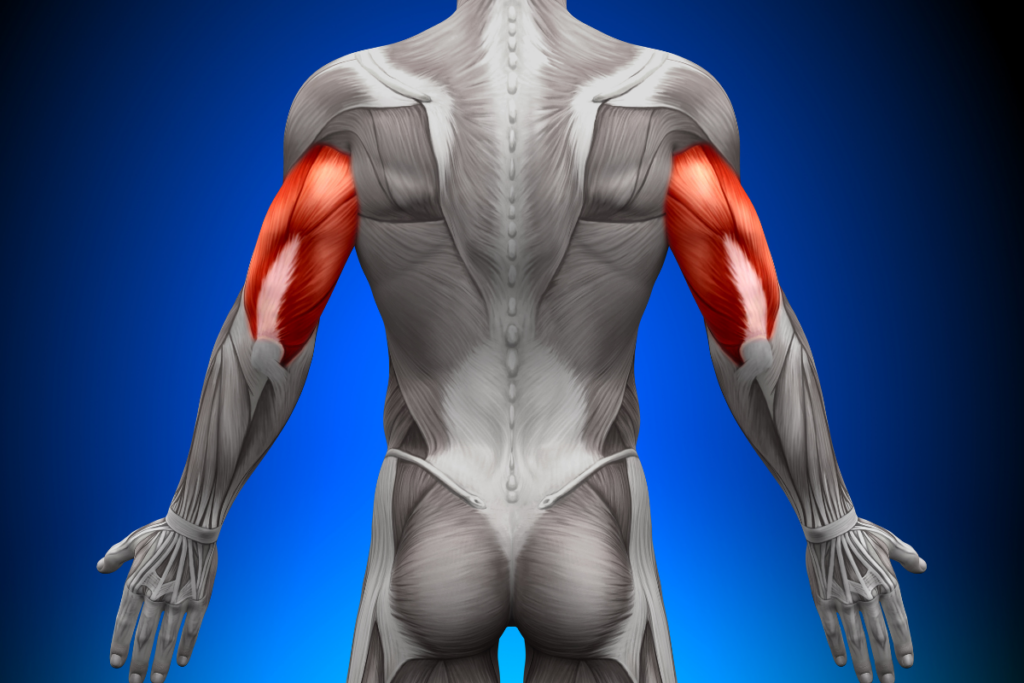
4 Benefits of Band Triceps Workout
Resistance band tricep workouts are amazing for you. Developing your triceps has its benefits, but using resistance bands to do it comes with even more advantages. Let’s have a look at some specific reasons why you should add resistance band tricep workouts to your fitness routine.
✅ Increased Joint Stability
The long head part of the tricep is responsible for shoulder joint stability and movement. By building up muscle mass, strength, and power, you increase the stability of your shoulder. That’s not the only joint stabilized by the tricep, though.
The elbow and wrist joints are also stabilized by the tricep. Remember that the lateral and medial heads span the entire length of the arm right down to the ulna. This added muscle mass and joint stability keeps your arms strong and able to withstand whatever resistance it encounters.
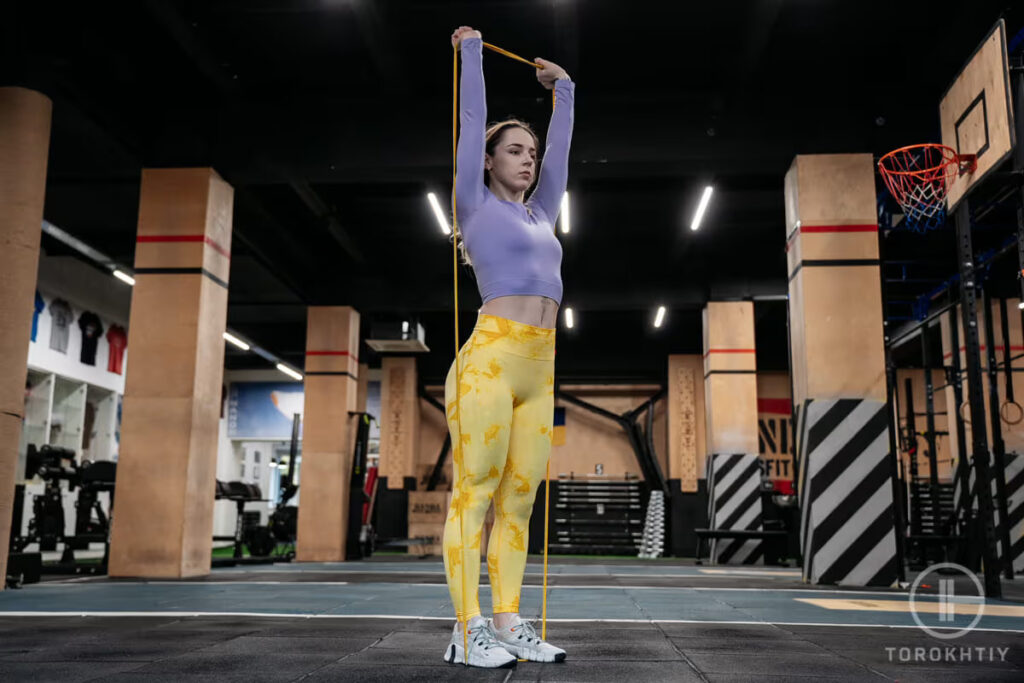
✅ Increased Strength and Power
The tricep is responsible for not only joint stability, but extension as well. Joint stability provides the ability to withstand resistance, but developing your triceps also builds strength and power. Your joints will move with much more fluidity and power behind it.
This power is particularly handy for athletes in sports like boxing, swimming, and powerlifting. Well trained triceps help develop power in your punch, stroke, or lift. It also helps out in your everyday life.
✅ Easy on Your Muscles and Schedule
Using resistance bands to develop your triceps comes with its own advantages. Using resistance bands to train your triceps helps you build all that strength and power without putting your muscles under too much stress. Resistance bands go easy on your muscles so well that they’re perfect for nursing yourself back from injury. They help develop strength without exerting as much stress on you as weights.
Resistance bands are very convenient to use, too. They’re easy to carry around and easy to use no matter where you are. If you’re someone who’s always on the move, resistance bands are exactly what you’re looking for.
✅ Added Variety to Your Routines
Another major advantage of doing tricep workouts with resistance bands is the flexibility it offers you. You get to try out different moves and workouts that will target your triceps specifically for the best possible results. Bands let you add variety to your movements to keep it fun and interesting, without taking a single bite from its effectiveness.
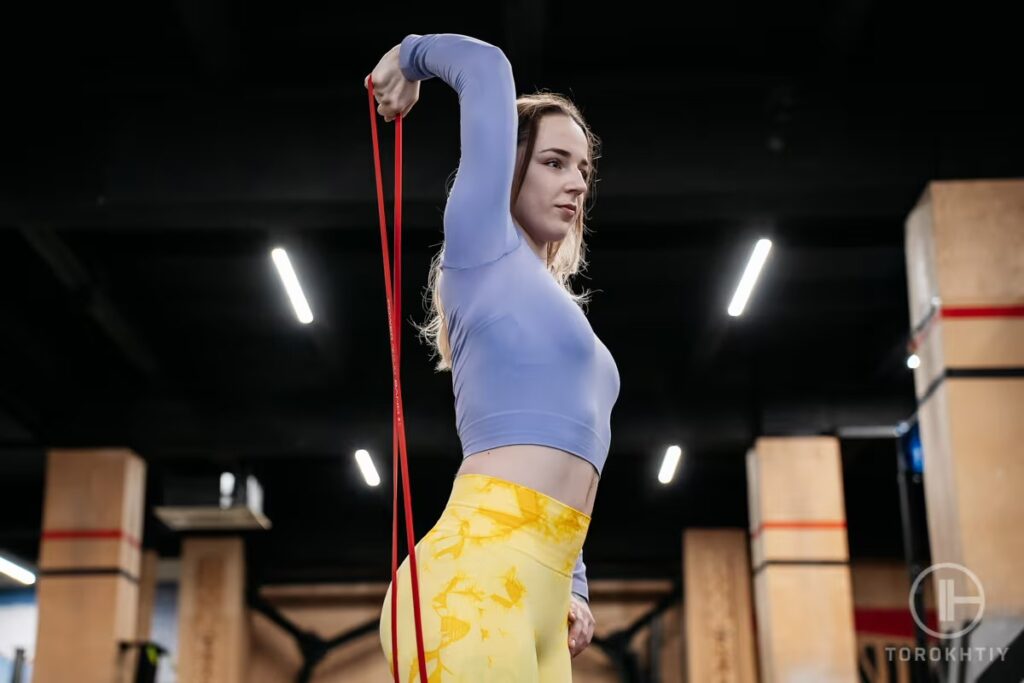
4 Top Tricep Workouts with Resistance Bands
Many people believe that using weights and performing compound workouts are enough to build strength in your tricep. Compound workouts do target your arm muscles, including your triceps, but they are nowhere near as effective as targeted tricep workouts. Targeted workouts will build your triceps up faster and more effectively.
Let’s have a look at some specific resistance band tricep exercises.
1. Band Push Downs
Resistance bands tricep pushdowns are one of the best targeted tricep workouts to do. They target the lateral and medial heads of your triceps and boost joint strength and stability. To do a band pushdown, anchor your resistance band against a high point.
If you’re at home, feel free to use a door hinge or anything solid and elevated. If you’re at the gym, a full rack will do.
Once you’re set with your anchor, pull on the band with both hands until your upper arm is straight down by your side and your forearms bent upwards toward the band. This is your starting position.
Pull the band downwards till your arms are straight down by your side and your thumb can touch your thigh. Then release back to starting position. Rinse and repeat as many times as you can.
2. Tricep Extensions
There are 3 variations of triceps extensions I’d like to talk about:
- High anchor triceps extensions
Tricep extensions are another exercise that makes you flex your triceps back and forth. It has several variations but let’s talk about the high anchor tricep extension. Hang your resistance band from a high spot just like with pushdowns, but stand with your back to it instead.
Find a stable stance with one leg ahead of the other, then pull the band till your elbows are straight out and your lower arms facing backwards and holding onto the bands. This is your starting position.
Once set, pull the band till your arms are stretched to full length and release back to starting position. Repeat this motion as many times as you can. Make sure to keep your core tight and your back straight as you workout.
- Overhead tricep extension
Overhead tricep extensions are a different tricep extension variation that’s also awesome for you. To do an overhead band tricep extension, place one foot in front of the other and step on the middle of your resistance band using the foot behind.
Pull the band up till you’re holding them up behind you with your elbows at a 90° angle. Make sure there’s already some tension in the band. This is your starting position.
Once set, pull the band upwards till your arms are stretched up overhead as far as they can go. Keep your arms close to your head and maintain a tight form. Lower your arms back to starting position and go again as many times as you can. You can also do a single hand overhead band tricep extension if you want to focus on one hand at a time.
- Crossbody tricep extensions
The 3rd variation on this list is the crossbody triceps extension. Anchor your band around an elevated anchor much like the high anchor extension. Hold the band while facing it, then turn around so that your arm is holding the band across your body.
Keep your upper arm straight outwards and your elbow at 90°, albeit slanted across your body. Use your free hand to support your pulling hand by placing it just beneath your upper arm. You can put one leg ahead of the other for stability.
That’s your starting position.
All you have to do then is to pull until your arm is stretched at full length outwards. Release back to the starting position and repeat the move as many times as you can.
3. Triceps Kickback
Tricep kickbacks are awesome for targeting your tricep. There are 3 variations of the kickback I’d like to talk about.
- Anchorless kickback
To do it, loop your band around the foot opposite to the hand you’ll be training. So if you’ll train your right arm, loop the band around your left foot. Then bend over such that your free elbow is resting on the leg with the band looped around it and your other leg is extended behind it.
Then grab your band and pull slightly to create some tension. Your elbow should be at a 90° angle with your upper arm straight along your side. This is your starting position.
Follow us!

Free!
Get a 2-week Weightlifting Program as a bonus for the subscription to kickstart your training plan!

Free!
Once ready, pull the band upwards so that your arm is extended straight out backwards. Drop back to the starting position and repeat as many times as you can.
- Anchored kickback
The anchored kickback requires the use of an anchor strap which is to be anchored around a place that’s about the height of your waist. Put your band in around your strap such that there’s an equal length on both sides. Pull on the bands so that there’s tension on either side and your elbows are bent to about 90°.
Then bend over such that your upper body is almost at 90° degrees to your lower body and bend your knees slightly as well. This is your starting position.
Once set, pull the bands with both arms till your arms are stretched out straight backwards. Release your arms back to starting position, then go again as many times as you can.
- Bench kickback
To do this variation, you would need a bench, either at the gym or at home. Anchor the band around the foot of the bench at one end. Go to the other end and kneel with the leg opposite your targeted hand on the bench while standing with your other leg.
Then bend over and support yourself on the bench with your free arm. Pull on the band to create some tension and keep your elbows at a 90° angle. This is your starting position.
Pull the band till your arm is fully extended backwards, release back to starting position, and then go again as many times as you can.
4. Reverse Grip Pulls
Reverse grip presses are another awesome workout targeted at building up your triceps. To do reverse grip presses, you need an anchor for your band directly above you. Loop your band around it such that you have two equal sides in your arms.
Pull the band to create some tension and keep your core tight and your upper arm straight down and attached to your side. This is your starting position.
Now all you have to do is pull down until your arms are straight facing downwards. Release back up to starting position and go again as many times as you can.
How to Pick Resistance Bands for Tricep Workouts?
As beneficial as tricep exercises with bands can be, you won’t get the best if you don’t pick the right bands. To avoid getting a low quality band, there are some things to look out for. Let’s look at some of them.
1. Strength and Durability
The first and most important thing to consider when shopping for a resistance band is strength and durability. The thicker the band, the more durable.
A thin band could easily snap as you use it. Go for a thicker band and save yourself the stress.
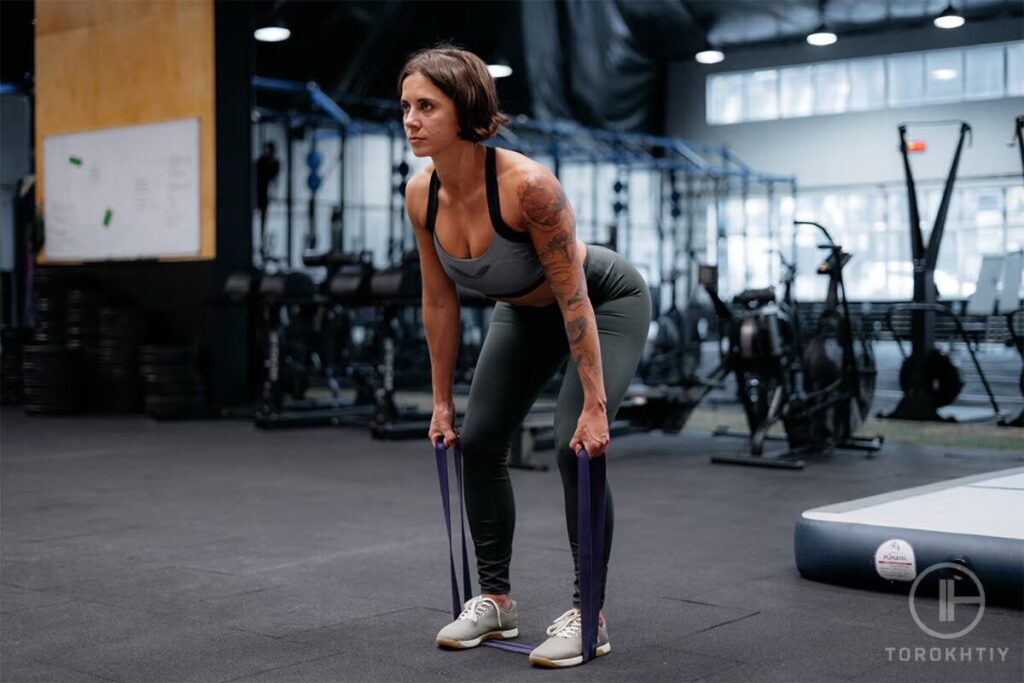
2. Type
There are two major types of resistance bands: flat and tube. Flat bands are great for rehabilitation and warmup drills because of their low resistance. Tube bands are much better for experienced fitness lovers or anyone looking to do some serious exercise.
3. Material
There are two major types of material used to make resistance bands: elastic fabric and rubber latex. Which one you go for will depend largely on your personal preference and fitness goals.
Elastic fabric bands are more comfortable and easy on your skin. They’re especially good for lower body workouts. Rubber latex bands, on the other hand, offer better stretching. It’s awesome for upper body workouts that involve explosive movements, stretching, and other advanced movements.
4. Buy a Set
Resistance bands could come single or in a set. It’s more recommended to get a set of resistance bands because you get a full set with different resistance levels. This not only gives you enough spares in case anything happens to the one you’re using, it also allows you to progress by increasing resistance levels as you grow.
Rogue Echo resistance bands
Rogue Echo resistance bands are topnotch bands made just for you. They’re made of rubber latex that provide excellent stretching and resistance.
They come in color coded different resistance levels ranging from light training for rehabilitation to maximum resistance for advanced workouts.

FAQ
Can You Build Triceps with Resistance Bands?
Yes, absolutely! Resistance bands are very effective for training your triceps. They allow a wider variety of movements and go easy on your muscles if you’re nursing an injury.
Why Do You Need to Target the Triceps?
Compound exercises are good for building strength in your big muscles, but your triceps require special attention. Targeted tricep workouts help develop muscle mass, strength, and explosiveness. This in turn makes several other movements such as boxing and powerlifting much easier.
Conclusion
Tricep workouts are essential to provide your arm with complete, rounded muscle growth and development. Resistance bands are effective for tricep workouts because of the extra flexibility they offer. Tricep exercises with bands are easy to learn and master, but they’re super effective in muscle development.
Now it’s your turn. What’s your favorite tricep band workout? Which benefit caught your eye the most? Is there anything I forgot to mention? Let’s talk about it in the comments!
Also Read:
- Bench Press With Resistance Bands
- Resistance Band Deadlift
- Shoulder Stretches With Bands
- Squats With Resistance Bands
- Chest Exercises With Bands
- Resistance Bands vs Weights
- Lat Pulldown With Resistance Bands
- Back Workouts With Resistance Bands
- Resistance Bands Guide
References:
- How to Add Compound Exercises to Your Workout Routine // Healthline:
https://www.healthline.com/health/fitness-exercise/compound-exercises - Photos made by Torokhtiy Media Team; photo by decade3d, Canva.
Why Trust Us?
With over 20 years in Olympic weightlifting, strength training, nutrition coaching, and general fitness our team does its best to provide the audience with ultimate support and meet the needs and requirements of advanced athletes and professional lifters, as well as people who strive to open new opportunities and develop their physical capabilities with us.
By trusting the recommendations of our certified experts in coaching, nutrition, and sports training programming, as well as scientific consultants, and physiotherapists, we provide you with thorough, well-considered, and scientifically proven content. All the information given in the articles concerning workout programming, separate exercises, and athletic performance, in general, is based on verified data.
The product testing process is described in more detail here.
Author: Ihor Shymechko
Pro Olympic Weightlifter, Coach
Best Results: Snatch – 208 kg,
C&J – 240 kg
Ihor has been a professional weightlifter since 1996, boasting over two decades of competition experience. His notable achievements include clinching the European Championship in 2009 and securing a silver medal in the 105kg division at the Senior World Championships in 2011. Ihor represented his country in the 2008, 2012, and 2016 Summer Olympics. After retiring from competitive weightlifting, he transitioned to coaching, leveraging his vast experience to guide athletes who now compete on both national and international stages.



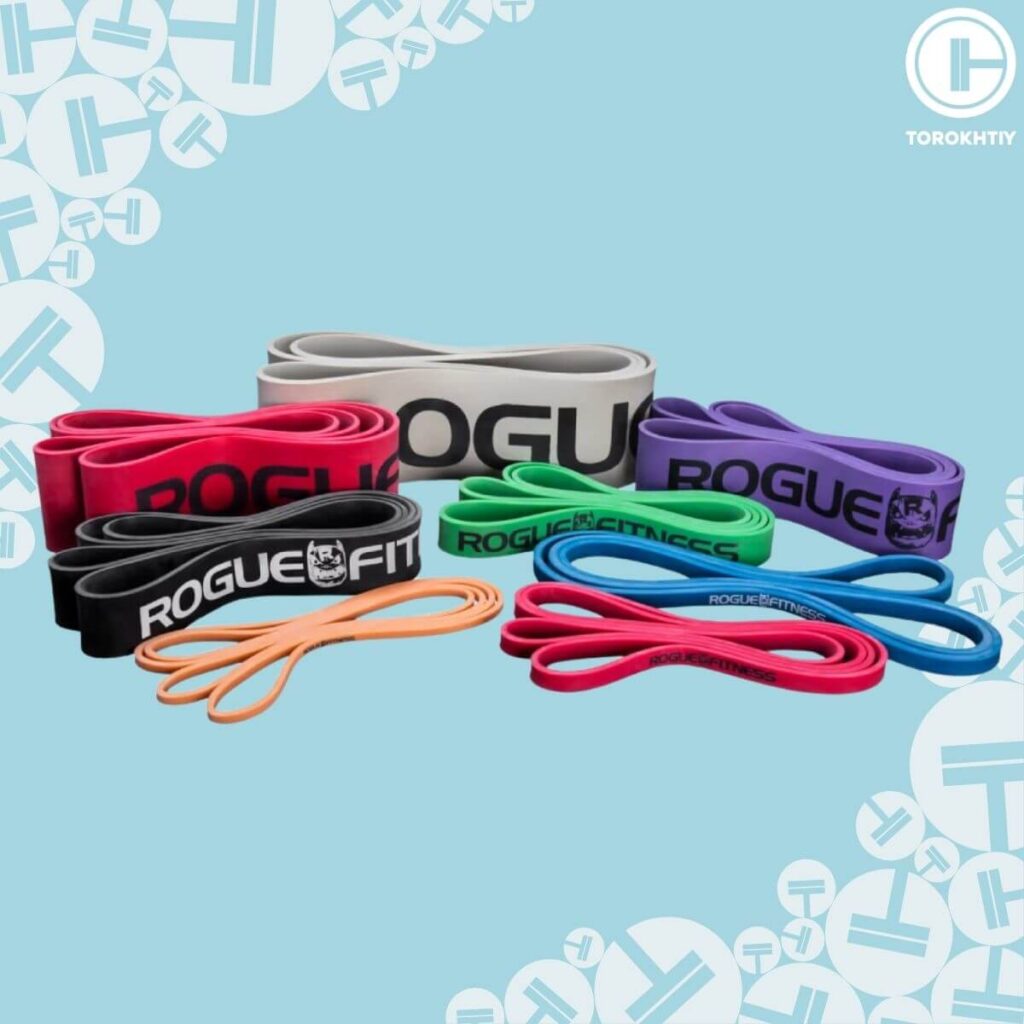
Still have questions after reading our article? Unlock your full potential by engaging with our experts and community! Don’t hesitate — leave a comment below and Ihor Shymechko will provide a personalized answer and insights to help you reach your goals.